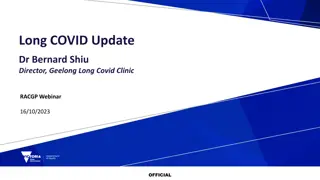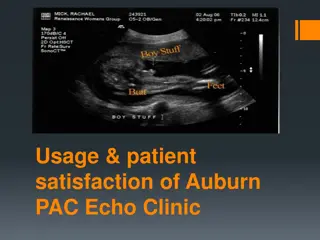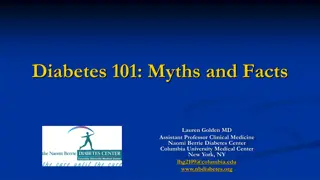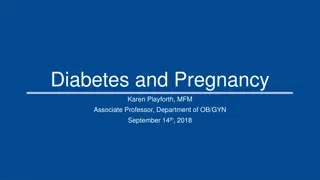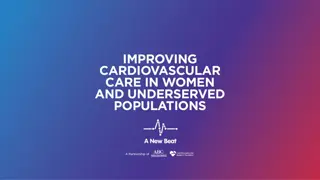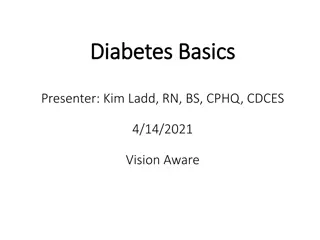Process Map for Patients Attending the Diabetes Clinic
This project involves creating a process map for patients attending the diabetes clinic, focusing on patient information leaflets, reliability of patients bringing urine samples, and more. The project aims to streamline patient flow and improve clinic efficiency.
Download Presentation

Please find below an Image/Link to download the presentation.
The content on the website is provided AS IS for your information and personal use only. It may not be sold, licensed, or shared on other websites without obtaining consent from the author.If you encounter any issues during the download, it is possible that the publisher has removed the file from their server.
You are allowed to download the files provided on this website for personal or commercial use, subject to the condition that they are used lawfully. All files are the property of their respective owners.
The content on the website is provided AS IS for your information and personal use only. It may not be sold, licensed, or shared on other websites without obtaining consent from the author.
E N D
Presentation Transcript
A Anatomy The lower respiratory system Dr. Kareem Obayes Handool Al Jebory
The larynx (voice box) is a component of the respiratory tract, located in the anterior neck. suspended from the hyoid bone, and spanning between C3 and C6. It is continuous inferiorly with the trachea, and opens superiorly into the laryngeal part of the pharynx. The larynx is formed by a cartilaginous skeleton, which is held together by ligaments and membranes. The laryngeal muscles act to move the components of the larynx for phonation and breathing.
The Tracheobronchial Tree The trachea, bronchi and bronchioles form the tracheobronchial tree: a system of airways that allow passage of air into the lungs, where gas exchange occurs. These airways are located in the neck and thorax. The trachea marks the beginning of the tracheobronchial tree. It arises as a continuation of the larynx. It travels inferiorly, bifurcating at the level of the sternal angle (forming the right and left main bronchi), at this bifurcation a ridge of cartilage called the carina. The trachea is held open by cartilage, here in C-shaped rings. The trachea and bronchi are lined by ciliated pseudostratified columnar epithelium, interspersed by goblet cells, which produce mucus. The combination of sweeping movements by the cilia and mucus from the goblet cells forms the functional mucociliary escalator. This acts to trap inhaled particles and pathogens, moving them up out of the airways to be swallowed and destroyed.
Bronchi At the level of the sternal angle, the trachea bifurcates into the right and left main bronchi. They undergo further branching to produce the secondary bronchi. Each secondary bronchi supplies a lobe of the lung, and gives rise to several segmental bronchi. Right main bronchus: wider, shorter, and descends more vertically than its left-sided counterpart. Clinically, this results in a higher incidence of foreign body inhalation. The structure of bronchi are very similar to that of the trachea, though differences are seen in the shape of their cartilage. In the main bronchi, cartilage rings completely encircle the lumen. However in the smaller lobar and segmental bronchi cartilage is found only in crescent shapes.
Transverse section of the trachea, showing its bifurcation. The trachea and bronchi Bronchioles The segmental bronchi undergo further branching to form numerous smaller airways, called the bronchioles. The smallest airways, bronchioles do not contain any cartilage or mucus-secreting goblet cells. Instead, club cells produce a surfactant lipoprotein which is instrumental in preventing the walls of the small airways sticking together during expiration. Initially there are many conducting bronchioles, which transport air but not involved in gas exchange. Conducting bronchioles then eventually end as terminal bronchioles. These terminal bronchioles branch even further into respiratory bronchioles, which are distinguishable by the presence of alveoli extending from their lumens. Alveoli are tiny air-filled pockets with thin walls (simple squamous epithelium), and are the sites of gaseous exchange in the lungs. Altogether there are around 300 million alveoli in adult lungs, providing a large surface area for adequate gas exchange.
The lungs are the organs of respiration. The function of the lungs is to oxygenate blood. They achieve this by bringing inspired air into close contact with oxygen-poor blood in the pulmonary capillaries. The lungs lie either side of the mediastinum, within the thoracic cavity. Each lung is surrounded by a pleural cavity, which is formed by the visceral and parietal pleura. Lobes The right and left lungs do not have an identical lobular structure. The right lung has; superior, middle and inferior. The lobes are divided from each other by two fissures: Oblique fissure and Horizontal fissure. The left lung contains superior and inferior lobes, which are separated by oblique fissure
The pleurae refer to the serous membranes that line the lungs and thoracic cavity. They permit efficient respiration. There are two pleurae in the body: one associated with each lung. Each pleura can be divided into two parts: Visceral pleura: covers the lungs. Parietal pleura: covers the internal surface of the thoracic cavity. There is a potential space between the viscera and parietal pleura, known as the pleural cavity. It contains a small volume of serous fluid. Mediastinum The mediastinum, or mediastinal cavity, is a visceral compartment of the thoracic cavity. It completely separates the two pleural cavities by being placed longitudinally between them. It extends from the superior thoracic aperture to the diaphragm. The main mediastinal contents are the heart, esophagus, trachea, thoracic nerves and systemic blood vessels.



